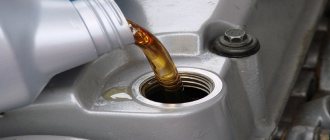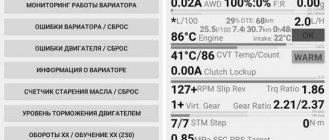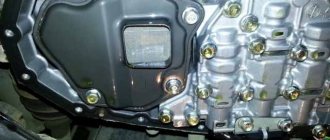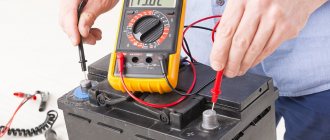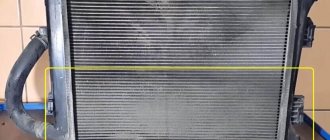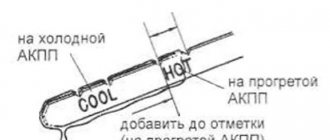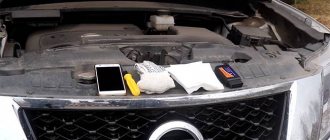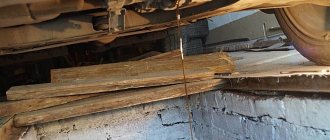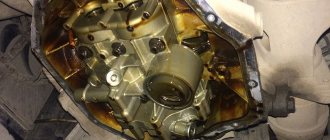The Mitsubishi Outlander is a compact crossover, first introduced by the Mitsubishi brand in 2001. However, official sales were launched only in 2003.
Below we will look at how to change the oil in a variator on a Mitsubishi Outlander 3, talk about the frequency of work, and highlight the main brands of oil and their features.
We will pay special attention to the replacement procedure, as well as subtleties and nuances that are not indicated in the manufacturer’s manual.
Mitsubishi Outlander how to check the oil level in the variator - let's look at the main thing
In order to extend the service life of the variator, special attention should be paid to such an indicator as the oil level in the gearbox. The level is checked with a dipstick located at the top of the transmission and should be between the maximum and minimum values, between the marks. The check procedure for Nissan, Honda or Mitsubishi cars is no different.
To make the measurement as accurate as possible, warm up the variator to the operating temperature of the transmission oil: 60-80 degrees. The check is carried out on a flat area, preferably after a long trip, the mileage depends on the time of year, in winter it is at least 30 kilometers. If the variator is not warmed up enough, there is a possibility of an error, do not neglect this rule.
Resource and replacement time
Mitsubishi Outlander automatic transmission oil change
Talk that the lubricant used in the transmission is designed for the entire service life of the car should not be taken seriously. There are reasons for this. The lubricant may lose its properties due to:
- dirt or particles of wearing parts getting into it (most often these are small particles of gradually deteriorating clutches);
- due to prolonged operation of the automatic transmission under high loads;
- due to overheating of the transmission, which also occurs as a result of engine overheating.
Taking into account Russian operating conditions, the oil change in the Mitsubishi Outlander automatic transmission should be done once every 60 - 80 thousand km. mileage Thus, it is possible to significantly increase the resource and improve the operation of the node. In cases where the lubricant smells burnt or contains foreign matter, maintenance should be performed immediately. Remember that automatic transmissions are designed for a relaxed driving style. Sharp starts from a standstill and rapid acceleration are disastrous for them.
Steps to check the oil level
There is also a regular probe
Cold and Hot measuring range
High oil level in the variator
Naturally, if it is low, you need to add the original liquid, but what if it is higher? It's simple. Take a large-volume syringe and a rubber tube, for example from a dropper. All this is sold in every pharmacy. Pump out the required volume and voila.
In order not to make a mistake with the ideal level, you need to fill in small doses and check the level more often. If, when checking, the liquid is less than the permissible values, you need to find out the reason. There might be a leak somewhere. Also evaluate the condition of the oil; it should not smell like burning and be light in color. In other cases, you need to change the oil; read the simple instructions and change the oil yourself.
I recommend this method to you, since when measuring cold the error will be larger.
Level in the variator
Last night I checked the ATF level in the box before putting it in the garage: everything was as taught - the engine is running, the selector is in position N. The level was 2mm below the lower HOT limit. In the morning before starting the engine, I checked it was cold and was amazed! The level was 1.5-2 mm above the upper limit of HOT. A little background: shortly before this, the bearing in the box was changed, the ATF was drained, a new one was poured in (partially), the rest was topped up with the old one (it’s still good too). After that, I drove about 500 km, it felt like everything was working fine, only the reverse gear somehow began to work differently - a little louder. Can anyone tell me what this glitch is?
Address: Moscow Novokosino Posts 173
Address: Kurgan Messages 197
Posted by marokann
Last night I checked the ATF level in the box before putting it in the garage: everything was as taught - the engine is running, the selector is in position N. The level was 2mm below the lower HOT limit. In the morning before starting the engine, I checked it was cold and was amazed! The level was 1.5-2 mm above the upper limit of HOT. A little background: shortly before this, the bearing in the box was changed, the ATF was drained, a new one was poured in (partially), the rest was topped up with the old one (it’s still good too). After that, I drove about 500 km, it felt like everything was working fine, only the reverse gear somehow began to work differently - a little louder. Can anyone tell me what this glitch is?
Address: Moscow Novokosino Posts 173
Posted by marokann
There’s not a word about CVTs...
By the method of checking the oil level, both a variator and a simple automatic transmission are the SAME.
Address: Kurgan Messages 197
Posted by kmiha
By the method of checking the oil level, both a variator and a simple automatic transmission are the SAME.
I agree the only difference is the position of the P or N selector.
Address: Kurgan Messages 197
Posted by marokann
How many kilometers did you travel before the inspection? It is recommended to drive 10-15 km before checking; the box will never warm up at idle speed.
Address: Chelyabinsk Posts 372
MMC Lancer Cedia Wadon, 4G93, 03/2001
I checked after driving 15 km that the selector was in neutral with the engine running. In short, everything is fine, guys. Thanks everyone for the advice.
2 Damon Thanks for the advice - registered!
Source
Changing the oil in a Variatre
Good morning everybody! Yesterday I changed the oil in the variator, at a mileage of 116,600 km, the previous owner changed the oil at a mileage of 75,000 km, it was filled with G-energy G box CVT, judging by the records of the work performed, there was a partial replacement. In principle, there were no reasons to change the oil to a new one. It was confusing that a universal one was filled in that was not suitable for tolerances J1 and J4. I bought Nissan NS-3 oil, in an iron can in the amount of 3 pieces of 4 liters each. 1) First of all, I prepared measuring dishes, a basin, funnels and containers for old oil; 2) Removed the engine protection; 3) Removed the variator oil level dipstick; 4) Using the key “19”, unscrew the plug of the variator pan and substitute a basin; 5) Used oil is reddish in color and transparent. About 4.2 liters spilled out;
6) Having unscrewed the variator pan with a tubular wrench to “10”, I poured out another 0.3 liters. A total of 4.5 liters of old oil came out of the variator;
7) There was not a lot of metal dust on the magnets, but I think this is within normal limits;
 Carefully removing the magnets, I cleaned them with gasoline and washed the tray itself. The gasket itself did not need to be changed; it was no different from the new one;
Carefully removing the magnets, I cleaned them with gasoline and washed the tray itself. The gasket itself did not need to be changed; it was no different from the new one;
9) Having unscrewed 3 bolts, using the same tubular wrench set to “10”, removed the coarse filter;
10) Installed a new filter, lubricating the rubber ring in advance. This rubber ring came with the filter itself. It was a shame that I just bought such an o-ring (2824A005), I didn’t know that it came with a filter in the kit;
11) Then, having unscrewed 4 bolts, using a “10” key, removed the fine filter along with the sealing rubber, a little more oil spilled out;
12) Lubricate the rubber ring of the fine filter with new oil and put it in place. Cover with a new lid with a rubber ring included. Remembering the recommendations on the out-club forum that the fine filter should be changed as a last resort, I removed the new filter with the housing and installed the old filter with the housing while draining the oil from the radiator;
13) Replaced the variator pan with a new gasket and a new plug with a ring. I tightened the pallet according to a pre-printed pattern. I also tightened it by hand with a socket wrench. Not much, gradually. 14) Having lubricated the junction of the rubber return hose with the tube that goes into the fine filter housing with silicone grease, loosened the spring clamp with pliers and moved the hose;
15) Since there was only one, I had to lengthen the return hose and bring it into view in order to control the filling of the old oil outlet;
16) First, I filled the variator with 6.5 liters of new oil using a funnel (2 liters more than I drained). I turned on the engine and pumped out 2 liters of old oil (1 liter at a time stopping the engine). The oil is filled into a liter container in about 8-10 seconds, i.e. you can check the filling. Then, in the same way, I filled in 1 liter of new oil and drained 1 liter of old oil (I did this procedure 5 times), and the last time I filled in 0.5 liters of new oil and drained 0.5 of the old one, fortunately 12 liters of oil were purchased. More or less greenish oil (new NS-3) came out after about 4 times (filled in 1 liter of new, drained 1 liter of old); 17) Having unscrewed the housing with the old fine filter, I put in place a new filter with a new housing.
Source
Changing the oil in the Mitsubishi Outlander 3 variator
According to the maintenance regulations, the oil in the variator is changed at a mileage of 75,000 km, we tightened it up a little, up to 85 thousand... There was no point in delaying it any longer, especially since we had a long trip to the sea ahead)) Information on the Internet on this issue, specifically for the 3rd There are very few outs, only using XL as an example, so I will try to describe everything in as much detail as possible, maybe it will be useful to someone))
Let's start with what you need to replace: 1. Oil for Mitsubishi CVTF J4 variator, art. MZ320288 (we took 6 bottles, but only 5 fit).
And the dealer wanted to dilute it by 8 liters, despite the fact that the filling volume is 7.1 liters, and the oil is not cheap...
2. Mitsubishi filter, art. 2824A006 3. Mitsubishi O-ring, art. 2920A096 4. Mitsubishi drain plug gasket, art.
2705A013 So, the replacement process itself.
1. Unscrew the plug on the pan and drain the old oil
While the oil is draining 1. Remove the air duct. Pull out the clips and snap them up
2. Remove the battery and its stand
To unscrew the wide bar you will have to assemble a structure like this, you can’t just get into it...
3. We get access to this thing, the filter is located in it, unscrew the bolts, open it, a little more oil drains from there, take out the filter, replace the filter with a new one and install a new gasket, put everything back together.
Then we collect everything in reverse order.
This is the oil that drained
We tighten the drain plug on the pan, for some reason the plug gasket turned out to be different, although this particular article is recommended both on the Internet and at the dealer, although maybe they were deceived in the store... so they left the old gasket.
Pour new oil into the hole where the dipstick for checking the oil level in the variator is located.
It is better to use a funnel for pouring, as the hole is narrow so as not to spill.
Fill to the required level. We start the car, let it idle for a while, and smoothly switch the gearbox to all positions. And we go for a drive enjoying the perfect work of the variator)))
Thank you all for your attention!
A post of anger, or a tale about how I live in a CVT changer
Last week I changed the engine oil at Rodnye Oils, and immediately found out whether they were doing a complete fluid change in the variator, to which I received a positive answer. I was happy because the service is 500 meters from my house, and yesterday I made an appointment with them for a replacement.
I arrived early, a Ford Focus was hanging on the lift at the time, and was in no hurry to go down. I waited about half an hour, naturally, the time for which I signed up had already passed. Ford left, and the master went out to smoke... Well, yes, I’m not in a hurry, I have a lot of time... Well, okay, then he lifted Aut on the lift and began to look at something. As it turned out, he was looking for where the fine filter was located. For some reason, I unscrewed the heat exchanger, then found the filter, which is located below near the pan, screwed the heat exchanger into place... I was nearby at that time, but the master persistently asked me to leave the box. Naturally, he was refused, because I had huge doubts about his straightforwardness.
Next, we removed the pan, after draining the slurry. Nothing critical. The liquid is transparent, clean, without impurities; there is a little metal dust on the tray magnets. We replaced the fine filter, the coarse filter, and put the pan in place. The technician pulled out the bolts, all but one, and prepared to add oil. I pointed out to him the unstretched bolt. A sidelong glance and muttering that he was going to re-extend them all anyway.
Then for some reason the engine boot was put back, attempts were made to climb in and tighten the heat exchanger, again removal of the boot, again attempts to pull it through, installation of the boot back... I stood on the sidelines and was freaked out by what was happening. The master again started muttering that I shouldn’t bother him, and even called the manager. We talked with the manager, I asked why he installed the boot, it would prevent him from gaining access to the return hose from the radiator, to which I heard the answer that “we don’t do a complete replacement, you were misled.” Get hurt. And there are at least two liters of old liquid there (and maybe more, I don’t understand CVTs yet). We poured in 5 liters of fresh liquid and set the level. For some reason, they checked the level of everything possible, the quality of the brake fluid, and eventually made a discount on the work... (it would have been better if they had made a detailed technical map for the third Out and rubbed the specialists’ noses in it)
So, the impressions are only negative. Moreover, I left simply in anger. Firstly, they were misled by the amount of work, and secondly, by a handy master who was seeing the third Out of MY 2017 for the first time, and he was very infuriated by the phrase “People like you only ruin your life.” Well, yes, well, yes, they almost gave me the car with the pan bolt unscrewed, for some reason they tried to remove the heat exchanger, and they didn’t even tell me that the replacement would not be COMPLETE.
Novosibirsk residents are asked to spread the post, warning everyone that in Rodnye oils you can only change the engine oil, and then only while supervising the masters. In general, it’s not for nothing that they say: If you want to do it well, do it yourself. Which I was once again convinced of. I didn’t see any changes in the operation of the variator, everything was the same as before.
Thanks to everyone who read. I still have questions for the Drive guru: 1. When should I change it next time? Now the mileage is 39,000 2. How much old slurry is left and how critical is it? 3. There are 4 liters of fresh liquid left. Maybe after 1500 km, drain 4 liters and fill with fresh?
Where was the service? - Native oils on Kurchatova 2, Novosibirsk. I won’t say anything about the network as a whole, it’s all about the people. But I don’t recommend anyone to go to Kurchatova 2. I will buy oil from them, but definitely not change it from them. 12800 - consumables and liquid, 1600 - work. Good roads and quality maintenance to everyone!
Source
Motors and gearboxes installed on Mitsubishi Outlander
The first generation car was equipped with two gasoline engines of 2.0 and 2.4 liters, and in 2004 a car with a turbocharged 2-liter engine with a power of 202 liters was released. With.
From 2005 to 2012, the second generation Mitsubishi Outlander was produced with a 2.0-liter manual transmission engine and a CVT, as well as a 2.4-liter power unit with a CVT only. As for the most powerful 3-liter version with 223 hp. s., it was equipped with a 6-speed automatic transmission.
In 2012, the third generation Mitsubishi Outlander was introduced, but sales began only at the end of 2013.
In 2014, the car underwent a restyling, in which the appearance and a number of technical components changed.
The car is offered in three engine options: 2.0, 2.4 and 3.0 liters with manual transmission, automatic transmission and CVT.
We will dwell on the option with a continuously variable transmission in more detail.
CVT oil change periods
Changing the oil in the Mitsubishi Outlander 3 CVT, like any other car, is a mandatory stage of operation. This is due to the high load on the gearbox and the need to reduce the degree of wear of its elements.
Transmission fluid helps in solving the following issues:
If nothing is done, the lubricant ages and loses effectiveness. It accumulates wear products that damage the gearbox. The “garbage” in the lubricating fluid acts as an abrasive substance and further accelerates wear.
The creators of the Mitsubishi Outlander 3 claim that the variator is capable of operating throughout its entire service life without replacing the lubricant. But that's not true.
In their assessment, the company’s experts did not take into account the operating realities in our region, which are more severe.
To avoid negative consequences, it is better to change the oil in the variator every 75-80 thousand kilometers.
If you miss the above deadline, negative factors may appear:
The above symptoms indicate the need for an urgent visit to a service station to replace the lubricant and, possibly, repairs.
So what do the numbers actually mean?
When it comes to synthetic oil versus conventional oil: Synthetic oils cost a little more, but they give your engine better, longer lasting performance than conventional oils. High-performance cars with high-tech engines should use fully synthetic ones, but for most cars either will do.
Synthetic/conventional oil blends are another popular option for SUV and light truck owners. They are almost as cheap as regular ones, but will provide protection under higher loads and higher engine temperatures if you do a lot of hauling and towing.
Finally, there are high mileage oils specifically designed for older vehicles. They contain anti-wear additives and sealing additives that help restore the flexibility of rubber seals in an older engine. If your car has over 75,000 km on the clock, this is another option worth considering.
We hope this makes your decision a little easier when you take your car in for an oil change!
Brands of oils and their analogues, filling containers for the Mitsubishi Outlander 3 variator
It is important to pay special attention to the choice of lubricant for the Mitsubishi Outlander 3 variator. Errors in this matter can lead to deterioration of the mechanism and additional malfunctions.
To avoid such consequences, it is important to buy only original oil from proven developers.
Mitsubishi Dia Queen CVTF-J1 lubricant is poured at the Mitsubishi plant.
Subsequently, you can use an improved version of the composition for the variator - CVTF J4.
This brand of transmission fluid is indicated on the dipstick.
For a full range of activities, about 12 liters will be required (including washing). But it is important to know that the filling volume of the CVT, according to the manual, is 5.5 liters. And after a major overhaul of the transmission, it increases to 7.1 liters. But we will dwell on this issue in more detail.
To avoid counterfeiting, buy liquid only from an official representative of the company. If there are none, you can contact the dealer through the official website and order the product online.
4 liters of original transmission fluid, at the time of writing, will cost about 4,000 rubles.
To avoid falling for a fake, consider the following recommendations:
If you have any doubts about the quality, it is better to refuse the deal, because the use of low-quality lubricant carries risks for the gearbox. It’s better to spend time choosing, but be sure of the quality.
To avoid mistakes, here are the article numbers of the main types of oil for Mitsubishi Outlander 3:
As an alternative, it is possible to use Nissan NS-2 series lubricants, which are also suitable for use in the Mitsubishi Outlander 3 variator. Here, focus on the following articles - 999MP-NS300P (1 l), KLE52-00004 (4 l).
As a last resort, it is allowed to purchase analogues of the following types:
Taking into account the experience of car owners, the use of RAVENOL ATF NS2/J1 Fluid is not recommended due to the high risk of CVT failure. Many car owners complain about its quality.
Note that some of the lubricants discussed above are made at the same plant, so the main attention must be paid to cost and quality.
After preliminary preparation, you can start working.
Three signs of a CVT malfunction
More and more modern cars of various brands are equipped with CVTs. Let us briefly consider the main problems that arise with these devices, and also introduce some ways to eliminate them.
Recently, a myth has taken hold about the unreliability of CVTs and the supposed impossibility of repairing them. However, this statement is not entirely true. Many specialized auto repair shops repair CVTs. The Inter-Auto service center diagnoses these devices and successfully services them. We also practice ordering the necessary spare parts if they are not in stock.
Questions about the cost of services or prices for parts can be asked through a special feedback form on the website.
Cone bearing wear
The most common cause of CVT malfunction begins with wear of the cone bearings, which causes a characteristic hum to be heard. Bearing noise occurs due to wear products getting onto their working surfaces, as a result of which they become unusable. Special oil filters retain the metal suspension for the time being.
Thus, timely maintenance of the bearings or replacing them with the necessary spare parts will prevent more serious problems with the variator.
Oil pump pressure relief valve jammed
The next reason that can cause problems with the variator is jerking and twitching of the vehicle, which occurs due to the jamming of the oil pump pressure relief valve. The same harmful wear products interfere with the normal operation of this unit, disrupting the stable pressure in the system. A timely visit to a specialized workshop will help you avoid larger repair costs. Minor damage to the bevel pulleys can be repaired by grinding, but the belt will most likely have to be replaced.
Malfunction in the gas turbine engine
Quite rare malfunctions that precede the breakdown of the variator include failure of the torque converter, as well as failures in the electronics caused by breakdowns of some elements of the control unit. However, this kind of malfunction occurs quite rarely and is not a pattern, but rather a factor of bad luck.
In general, the prospects for CVTs are quite optimistic and statistics show that they fail no more often than hydromechanical gearboxes. The main thing is to diagnose the malfunction in a timely manner and eliminate it in a timely manner. The qualified specialists of our auto repair shop will help you with this.
Replacement procedure
The algorithm of actions consists of several stages - removing old oil, washing, replacing the filter and filling in a new lubricant. Let's look at each of the steps in more detail.
Removing old grease
Note that you can do without a watering can, but in this case the container must be brought directly to the hole.
Cleaning the Mitsubishi Outlander 3 variator (with complete replacement)
Replacing the filter and cleaning the pan
Follow these steps:
Important! You can do without removing the battery and support. In this case, it is necessary to unscrew the bolts from the pit.
Filling with new oil (carried out through the hole for measuring the dipstick level):
This concludes the activities. Theoretically, you can skip the work of flushing and cleaning the crankcase, but it’s better not to do this. When choosing a flushing agent, the original oil for the variator is suitable. It is not recommended to use anything else.
After completing the work, after 30-40 km, check the variator housing for leaks. If everything is fine, top up and continue operation.
What kind of oil should I fill in?
CVT oil for Mitsubishi Outlander XL – DIA QUEEN CVTF-J1. This is the original oil, which was created specifically for Outlander XL. When purchasing, you need to be sure that it is not a fake, so you need to buy oil from trusted stores. By the way, for a high-quality oil change in the Outlander you will need 12 liters of oil. This is the kind of oil for the Mitsubishi Outlander 3 variator that you need to buy in these quantities.
In the IE there is only a drawing indicating where the probe is located.
On a “cold” car (sitting for hours, took out the dipstick
took out the dipstick
Wipe it with a clean rag. It has three slits (marks) between two “kinks”. There are two inscriptions - HOT and COLD. ABOVE the second “kink” there is also the inscription “ADJAST AT HOT” (Adjust on hot)
I inserted the dipstick back into the neck and took it out. We have a level.
It’s just not clear – is this normal or not?
Here are instructions for checking from another machine
Last edited by encephalopath; 06/27/2011 at 17:30.
If a CVT transmission uses low-quality lubricant, it will not be able to perform its intended functions. As a result, friction on the internal parts of the transmission will increase, which will lead to premature wear of the transmission components. Because of this, wear products will clog the channels of the lubrication system. Difficulties will arise when switching different gearbox modes, the box will begin to work with jerks and jolts.
The saddest consequence of untimely replacement of lubricant is complete failure of the unit.
What is oil degradation and how to reset the meter
In the Mitsubishi Outlander 3 ECU with a CVT there is a so-called oil degradation counter. The official name is CVT oil degradation level. When calculating the parameter, only the temperature of the lubricant in the gearbox is taken into account.
During operation, the counter awards points according to the following principle:
As soon as the temperature reaches 138 0 C, system information appears about gearbox overheating. If this parameter increases to 149 0 C, the variator operates in emergency mode.
This counter is intended only to inform the driver and does not send any commands to other elements of the car.
Information from the degradation counter can be obtained using a MUT-3 scanner or other similar devices. As an option, it is possible to use the ELM 327 diagnostic adapter with Android software such as hobDrive, Torque Pro or cvtz50.
When changing the oil in the variator, it is not necessary to reset the counter. It is advisable to do this according to the manufacturer’s recommendation, so service station specialists do not skip this manipulation. You can do the reset yourself using the cvtz50 software.
You can analyze the meter parameters by comparing the received data with the information on the odometer. After pouring new lubricant into the Mitsubishi Outlander 3 variator, we take the odometer data as zero.
Next we do the following analysis:
Many car owners have a “0” on their degradation meter. This is normal, because if there is no overheating above 90 degrees Celsius, points are not awarded.
The likelihood of overheating is very low, thanks to the presence of a radiator, so the lubricant rarely heats up above 85 degrees Celsius. Older versions of the Mitsibisi Outlander (before CVT8) had an old type of radiator that did not do its job very well.
Judging by the information from the CVTz50 program, the oil temperature in the variator in summer and winter is in the range from 50 to 85 degrees Celsius (average).
To reset the grease degradation counter in the Mitsubishi Outlander 3, you will need:
The CVTz50 program is paid and costs about 150 rubles.
To reset the degradation counter on the Mitsubishi Outlander 3, do the following:
If everything is done correctly, a log of information exchange between the adapter and the program appears on the display.
Next, find the oil degradation point and reset it to zero.
If desired, you can reset the data using MUT-3.
To do this, take the following steps:
Is it necessary to reset the counter?
Motorists who operate cars with CVT transmissions installed on them are naturally interested in one question. It concerns whether the counter needs to be reset.
The answer here is clear. On vehicles with CVT, zeroing is a mandatory procedure. If you are serviced by an authorized dealer, the specialists themselves will be able to reset the sensor and begin a new aging count. Performing a reset yourself is more difficult.
Many service books state that it is necessary to reset the oil aging sensor in the box. There are 2 main reasons why this is done:
- This information makes it clear in what mode the car and the variator itself are operated. That is, specialists and ordinary motorists can find out if there are problems with the CVT after its last reset.
- If you remove the oil aging sensor on the variator after replacing it, this makes it easier to determine the next replacement date in the future.
- On some cars, if you do not reset the parameters, the meter will cause an error to appear when connecting specialized diagnostic equipment.
From the position of a car owner, he does not really need such information. But this is a good way to find out the details of the operation of a car with a CVT when buying a car on the secondary market.
The presence of errors when connecting a diagnostic device or a large number of points over a short period of operation allows us to naturally assume that the variator was operated in very difficult conditions, and therefore quite serious problems may arise with it in the near future. The buyer would rather refuse to buy such a car.
Alas, CVTs are still far from perfect. These are the most vulnerable and delicate gearboxes, very susceptible to stress. The delicacy of CVT forces buyers in the secondary market to be extremely careful when purchasing used cars with a CVT.
Only after making sure that the variator was not loaded and was operating normally can you agree to the deal. An oil aging meter will provide significant assistance in this matter.
How much does it cost to change the variator oil on a Mitsubishi Outlander 3 at a service station?
The oil change service for a Mitsubishi Outlander 3 CVT is available at many service stations, but the price may vary depending on the service policy and region. If desired, you can order different services - partial replacement (after draining by gravity), complete displacement and work with removing/cleaning the pan.
A standard replacement (without flushing) with zeroing the degree of oil decomposition will cost 750-1000 rubles (excluding the cost of transmission fluid).
The second option (with complete displacement) is the most popular. It implies the following set of works:
On average, the cost of work is 3000-3500 rubles.
A full range of work, which involves removing and cleaning the pallet, costs about 5,000 rubles.
Flushing the radiator and replacing the fine filter will cost 1,500 rubles and 1,900 rubles, respectively, if you order them as separate services.
In all cases, the cost of the lubricant for the Mitsubishi Outlander 3 CVT is not included in the price. It must be purchased separately.
In the case of Ukraine, a regular replacement will cost 200-300 hryvnia, and the full version (with washing of all elements in the gearbox) will cost 1000-1200 hryvnia.
Subtleties and nuances that are not mentioned in the manual
Replacing the lubricating fluid in the Mitsubishi Outlander 3 variator box is a responsible process that requires taking into account some important points.
Let's highlight the main ones:
- You will have to tinker with unscrewing the battery support pads, so prepare suitable keys in advance or think about how you will get to this place.
- For convenience, the heat exchanger bolt (the one at the bottom) should be unscrewed from the fender liner.
- When removing the pan, be careful, because there is still about 500 ml of oil there. Also, pay attention to the size of the bolts. In some Mitsubishi Outlander 3 CVTs they may differ.
- Before purchasing a pan gasket, count the number of bolts that must match the holes in the gasket itself. Centering lugs are not included in the count. Usually there are 18 of them.
- Use caution when removing the CVT filter. Its edges are very sharp, so there is a risk of skin damage.
- It is recommended to clean the coarse filter in a special bath with a cleaning solution. You won't get away with regular blowing.
- When pulling the coarse filter bolts, it is important not to strip the threads. Use a torque wrench. The average tightening torque is 7.9 N*m.
- It is recommended to wash everything from oil with gasoline on the table, because it is more convenient.
- The amount of oil that is drained for the first time is different for everyone - from 6 to 8 liters. Remember that a lot of dirty fluid remains in the pan and must also be drained.
- The oil level in the Mitsubishi Outlander 3 variator must be measured only with the engine running and warm, with the gear lever in the “N” or “P” position. After completing all activities, it is recommended to drive several tens of kilometers. Make sure that the car is standing on a flat surface, and the level itself should be in the area of the letter “H” between the middle and top marks (temperature 800C). When the oil is not heated, its level varies in the area of the letter “C” between the lower and medium marks.
- The protrusions on the dipstick do not play any role, so do not pay attention to them when measuring the liquid level. They are needed so that the dipstick stays in the tube and when measuring the oil does not smear on it.
In general, 5.5-6 liters are enough for replacement, but it is better to take 12 at once to flush the variator. Another option is to buy three four-liter cans. At the same time, the latter still has about 50% left for refilling. If you drain more from the torque converter, it can take up to 8 liters, but this is not necessary.
